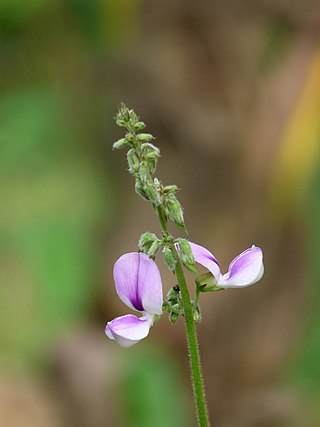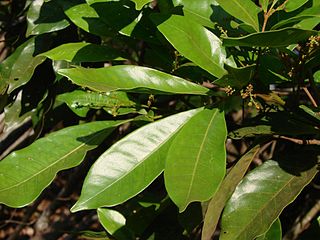
Mimosa is a genus of about 600 species of herbs and shrubs, in the mimosoid clade of the legume family Fabaceae. Species are native to the Americas, from North Dakota to northern Argentina, and to eastern Africa as well as the Indian subcontinent and Indochina. The generic name is derived from the Greek word μῖμος (mimos), an "actor" or "mime", and the feminine suffix -osa, "resembling", suggesting its 'sensitive leaves' which seem to 'mimic conscious life'.

Anacardium, the cashews, are a genus of flowering plants in the family Anacardiaceae, native to tropical regions of the Americas. The best known species is Anacardium occidentale, which is commercially cultivated for its cashew nuts and cashew apples.

Scaevola is a genus of flowering plants in the Goodenia family, Goodeniaceae. It consists of more than 130 species, with the center of diversity being Australia and Polynesia. There are around 80 species in Australia, occurring throughout the continent, in a variety of habitats. Diversity is highest in the South West, where around 40 species are endemic.

Prosopis is a genus of flowering plants in the family Fabaceae. It contains around 45 species of spiny trees and shrubs found in subtropical and tropical regions of the Americas, Africa, Western Asia, and South Asia. They often thrive in arid soil and are resistant to drought, on occasion developing extremely deep root systems. Their wood is usually hard, dense and durable. Their fruits are pods and may contain large amounts of sugar. The generic name means "burdock" in late Latin and originated in the Greek language.

Pueraria is a genus of 15–20 species of legumes native to south, east, and southeast Asia and to New Guinea and northern Australia. The best known member is kudzu, also called Japanese arrowroot. The genus is named after 19th century Swiss botanist Marc Nicolas Puerari.

Plumeria, also known as frangipani, is a genus of flowering plants in the subfamily Rauvolfioideae, of the family Apocynaceae. Most species are deciduous shrubs or small trees. The species are native to the Neotropical realm, but are often grown as cosmopolitan ornamentals in tropical regions, especially in Hawaii, as well as hot desert climates in the Arabian Peninsula with proper irrigation.

Terminalia is a genus of large trees of the flowering plant family Combretaceae, comprising nearly 300 species distributed in tropical regions of the world. The genus name derives from the Latin word terminus, referring to the fact that the leaves appear at the very tips of the shoots.

Calliandra is a genus of flowering plants in the pea family, Fabaceae, in the mimosoid clade of the subfamily Caesalpinioideae. It contains about 140 species that are native to tropical and subtropical regions of the Americas.

Chrysobalanaceae is a family of flowering plants, consisting of trees and shrubs in 27 genera and about 700 species of pantropical distribution with a centre of diversity in the Amazon. Some of the species contain silica in their bodies for rigidity and so the mesophyll often has sclerenchymatous idioblasts. The widespread species Chrysobalanus icaco produces a plum-like fruit and the plant is commonly known as the coco plum.

Parkia is a genus of flowering plants in the family Fabaceae. It belongs to the mimosoid clade of the subfamily Caesalpinioideae. Several species are known as African locust bean.

Swainsona is a genus of about 85 species of flowering plants in the family Fabaceae, and is endemic to Australia. Plants in this genus are herbs or subshrubs with imparipinnate leaves and usually purple flowers similar to others in the family.

Astronium is a genus of flowering plants in the cashew family, Anacardiaceae. It is native to Central and South America.

Zieria is a genus of plants in the family, Rutaceae. About sixty species have been formally described, all of which are endemic to Australia except for one species which is found in New Caledonia. They occur in all Australian states except Western Australia but the genus is under review and a number of species are yet to be described or the description published. Zierias are similar to the better known genus Boronia but can be distinguished by the number of stamens in the flowers. The name Zieria honours the Polish botanist John Zier.

Tapirira is a genus of flowering plants in the family Anacardiaceae. It includes nine species native to the tropical Americas, ranging from southern Mexico through Central America and northern South America to Bolivia, Paraguay, and southern Brazil.

Canavalia is a genus of plants in the legume family (Fabaceae) that comprises approximately 62 species of tropical vines. Members of the genus are commonly known as jack-beans. It has a pantropical distribution.

Flemingia is a genus of plants in the family Fabaceae. It is native sub-Saharan Africa, Yemen, tropical Asia, and Australasia. In Asia the species are distributed in Bhutan, Burma, China, India; Indonesia, Laos, Malaysia, Nepal, Pakistan, Papua New Guinea, Philippines, Sri Lanka, Taiwan, Thailand and Vietnam. The genus was erected in 1812.

Lumnitzera is an Indo-West Pacific mangrove genus in the family Combretaceae. An English common name is black mangrove. Lumnitzera, named after the German botanist, Stephan Lumnitzer (1750-1806), occurs in mangroves from East Africa to the Western Pacific, and northern Australia.
François Poupart (1661–1709) French physician, anatomist and entomologist.
Poupartiopsis is a monotypic genus of flowering plants belonging to the family Anacardiaceae. The only species is Poupartiopsis spondiocarpus.

















